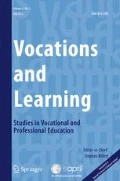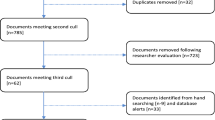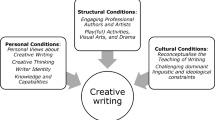Abstract
In the present article I will be discussing the importance attributed to aesthetic experiences in the vocational education of bookbinding master Wolfgang B. using the philosophy of Friedrich Schiller both to understand what constitutes these processes and to examine Schiller’s thoughts in the light of his recollections. By doing this I hope to elaborate on a potential, and often overlooked, Bildung-related possibility or affordance at least in craft vocational education and training (VET) as well as to articulate a pattern that can be generalized from into other VET contexts.
This leads to a richer understanding of the potentials inherent in teaching skills or capabilities and the pedagogy needed to elicit these as opposed to the belief that teaching technique is a straightforward and unambiguous issue of manual practice. These are in the realm of aesthetic and ethical learning potentials (given that such learning is never automatic) as well as in the connections that one might establish to various fields of scientific and cultural knowledge. Through all of this there emerges a partial description of a vocational Bildung tradition that has its roots in the teaching of crafts.
Similar content being viewed by others
Notes
In this I follow Dewey’s understanding of aesthetic experience as being about far more than appreciating “high art”, in effect it is the quality of an experience that determines if it is aesthetic rather than what is experienced (Dietrich et al. 2013:59f).
This emphasis on aesthetic activity rather than aesthetic experience is one of the reasons that Schiller’s Letters are more relevant to the present perspective than Dewey’s Art as experience Rittelmeyer (2005 [1934]). Not that aesthetic experience is irrelevant to Schiller but rather that aesthetic activity implies a more intentional stance on the part of the subject. Aesthetic Bildung is not something we experience passively but something that requires an aesthetic act.
In my reading of Schiller I am taking a rather a-historic approach and the conclusions I draw are, at least to some degree, not to be found explicitly in his own writing. Furthermore, as Hansjörg Hohr remarks (Hohr 2002a:61): there is hardly a statement in his oeuvre which is not contradicted, or so it seems, at another place. The point for me, though, has not been to remain utterly faithful to Schiller’s own thought or to reconstruct its historical development. It has been rather like finding an old but perfectly made tool and using it with materials that were not available at the time the tool was made this in turn casting new light also upon the tool itself. This is also the reason why I have been content to make use of the Letters and leave aside Schiller’s other writings. Other discussions of Schiller’s contemporary educational value can be found in Hohr 2002a; 2002b; Rittelmeyer 2005; 2012a; Vinterbo-Hohr and Hohr 2006. I have refrained from involving the wider discussion to be found in philosophical writing on aesthetics such as in Gadamer mostly because it would require too much space. This does leave a number of critical perspectives on Schiller by the side and I refer the interested reader to Christian Rittelmeyer’s excellent review and discussion (2005).
Schiller more commonly calls the sense-drive ”Stofftrieb” which could be translated as material, substance or stuff, none of which read easily in English. The following discussion of his concepts should clarify his choice of words.
The German word Spiel is actually a blend of what the words play and game denote in English.
I have translated this, and the following quotes from Schiller’s text from the German original.
Gestalt is difficult to translate from German and so it often remains as in Gestalt therapy. The direct translation would be form and in the context of how Schiller characterizes the form drive it makes sense to understand it in terms of the spiritually or ideally formative force or gesture that gives form to a living process.
Dunne’s discussion is especially relevant since his critique is that there exists a belief that one can reduce teaching to a simple exercise of technique, subject to straightforward evaluation. What happens is that technique ends up being equated with the same kind of mastery that a machine has and then evaluated as either desirable (teaching thereby becomes accountable and possible to research in a mechanical manner) or undesirable (teaching is thereby reduced to a mere skilled reproduction of what “science” has determined is the best method). I think the combination of Wolfgang B.’s case and Schiller’s thoughts call this view into question even though it follows from Schiller that one might well find any number of cases where technique has become nothing more than replicating a machine. This however is not a necessity but a consequence of how someone was taught and that same someone understood to learn. If being like machines is the metaphor we feel best captures what we want skill-education to be then fine, but it is hardly the only metaphor available.
The claim that this goes back to Hans Sachs is Mr. B’s. I have not been able to verify it having found it in several different versions and generally passed on as words of wisdom among German craftsmen. It crops up in any number of places when one starts to look, for instance quoted in a plenary session in the German Bundestag June 27th 2003 regarding changes in laws governing crafts (Handwerksordnung). Perhaps this is a less manifest reason for the success of the German apprenticeship system, that there still exists a strong culturally based Bildung tradition among those who look back to the apprenticeship system as their source.
References
Billett, S. (2011). Vocational education. Purposes, traditions and prospects. New York: Springer.
Brater, M., & Wagner, J. (2011). Künstlerische Aufgabenstellungen in der Erwachsenenbildung. München: Rainer Hampp.
Brater, M., et al. (1985). Fachübergreifende qualifizierung durch künstlerische Übungen. München: Rainer Hampp.
Brater, M., et al. (1986). Brücke zwischen Schule und Beruf. Der Förderlehrgang Voith. München: Rainer Hampp.
Brater, M., et al. (1987). Fachausbildung + Künstlerische Übungen. Ein Weg zur Förderung beruflicher Handlungsfähigkeit. München: Rainer Hampp.
Brater, M., et al. (2011). Kunst als Handeln – handeln als Kunst. Was die Arbeitswelt und Berufsbildung von Künstlern lernen können. München: Bertelsmann.
Corsten, M., & Lempert, W. (1997). Beruf und Moral. Weinheim: Deutscher Studien Verlag.
Crawford, M. (2009). The case for working with your hands. New York: Penguin.
Dewey, J. (1966) [1902]. The child and the curriculum. Chicago: Chicago University Press.
Dewey, J. (2005) [1934]. Art as experience. New York: Perigree.
Dietrich, C., et al. (2013). Einführung in die ästetische Bildung. Weinheim: Belz Juventa.
Dormer, P. (1994). The art of the maker. Skill and its meaning in art, craft and design. London: Thames and Hudson.
Dormer, P. (Ed.). (2010). The culture of craft. Manchester: Manchester University Press.
Dunne, J. (1993). Back to the rough ground. Practical judgment and the lure of technique. Notre Dame: University of Notre Dame Press.
Elbaz-Luwisch, F. (2014). Auto/biography & pedagogy. Memory & presence in teaching. New York: Peter Lang.
Frayling, C. (2011). On craftsmanship. London: Oberon Books.
Gessler, L. (1988). Bildungserfolg im Spiegel von Bildungsbiographien. Frankfurt: Peter Lang Verlag.
Gonon, P. (2002). Georg Kerschensteiner: Begriff der Arbeitsschule. Darmstadt: Wissenschaftliche Buchgesellschaft.
Hohr, H. (2002a). Does beauty matter in education? Friedrich Schiller’s neo-humanistic approach. Journal of Curriculum Studies, 34(1), 59–75.
Hohr, H. (2002b). Illusion—how Friedrich Schiller can cast light on Bildung. Journal of Philosophy of Education, 36(3), 487–501.
Josselson, R. (2004). The hermeneutics of faith and the hermeneutics of suspicion. Narrative Inquiry, 14(1), 1–28.
Keim, W. (1985). Praktisch-berufliches lernen als teil der allgemeinbildung—eine historisch-systematische studie. In F. Edding (Ed.), Praktisches Lernen in der Hibernia-Pädagogik. Klett-Cotta: Stuttgart.
Kemmis, S., & Smith, T. (Eds.). (2007). Enabling praxis: challenges for education. Rotterdam: Sense publishers.
Lange, U., et al. (2001). Studienbuch Theorien der beruflichen Bildung. Bad Heilbrunn: Klinkhardt.
Larsson, S. (2009). A pluralist view of generalization in qualitative research. International Journal of Research & Method in Education, 32(1), 25–38.
Obermann, A. (2013). Im Beruf Leben finden. Allgemeine Bildung in der Berufsbildung—didaktische Leitlinien für einen intergrativen Bildungsbegriff im Berufsschulunterricht. Göttingen: V & R Unipress.
Rist, G., & Schneider, P. (1979). Integrating vocational and general education: a Rudolf Steiner school. Hamburg: Unesco institute for education.
Rittelmeyer, C. (2005). Über die ästhetische Erziehung des Menschen. Eine einführung in Friedrich Schillers pädagogische Anthropologie. München: Juventa.
Rittelmeyer, C. (2012a). Bildung, ein pädagogischer Grundbegriff. Stuttgart: Kohlhammer.
Rittelmeyer, C. (2012b). Warum und wozu ästhetische Bildung? Oberhausen: Athena.
Schiller, F. (2010). Über die ästethische Erziehung des Menschen. Stuttgart: Reclam.
Schmalenbach, B. (2007). Eine heilpädagogische Psychologie der Hand. Luzern: Edition SZH/CSPS.
Schmalenbach, B. (2011). Kunst in der Ausbildung sozialer Berufe. München: Kopaed.
Sennett, R. (2008). The Craftsman. London: Penguin Books.
Smeyers, P., & Verhesschen, P. (2001). Narrative analysis as philosophical research: bridging the gap between the empirical and the conceptual. Qualitative Studies in Education, 14(1), 71–84.
Thomas, G. (2010). Doing case study: abduction not induction, phronesis not theory. Qualitative Inquiry, 16(7), 575–582.
Vinterbo-Hohr, A., & Hohr, H. (2006). The neo-humanistic concept of bildung going astray: comments to Friedrich Schillers thoughts on education. Educational Philosophy and Theory, 38(2), 215–230.
Volanen, M. V. (2012). Theoria, praxis, poiesis. Dissertation: University of Jyväskylä.
West, L. (2001). Doctors on the edge. General practitioners, health and learning in the inner-city. London: Free association books.
Wilson, F. R. (1998). The Hand: how its use shapes the brain, language and human culture. New York: Pantheon books.
Winch, C. (2012). Dimensions of expertise: a conceptual exploration of vocational knowledge. London: Continuum.
Author information
Authors and Affiliations
Corresponding author
Rights and permissions
About this article
Cite this article
Tyson, R. Aesthetic Bildung in Vocational Education: The Biographical Case of Bookbinding Master Wolfgang B. and His Apprenticeship. Vocations and Learning 7, 345–364 (2014). https://doi.org/10.1007/s12186-014-9120-1
Received:
Accepted:
Published:
Issue Date:
DOI: https://doi.org/10.1007/s12186-014-9120-1




